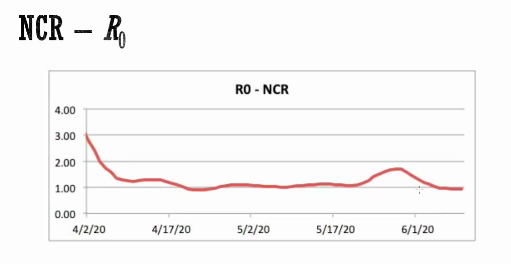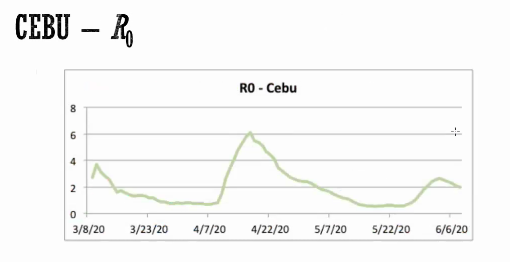40,000 COVID-19 cases seen by June 30 based on current trend: UP research | ABS-CBN

Welcome, Kapamilya! We use cookies to improve your browsing experience. Continuing to use this site means you agree to our use of cookies. Tell me more!
40,000 COVID-19 cases seen by June 30 based on current trend: UP research
40,000 COVID-19 cases seen by June 30 based on current trend: UP research
Kristine Sabillo,
ABS-CBN News
Published Jun 11, 2020 02:02 PM PHT
MANILA — Coronavirus disease (COVID-19) cases in the country may potentially reach 40,000 by the end of June, a research group from the University of the Philippines said on Thursday.
“Yung projection ay 40,000 cases by June 30,” said UP mathematics professor Dr. Guido David during a media briefing with the Department of Health on Thursday.
MANILA — Coronavirus disease (COVID-19) cases in the country may potentially reach 40,000 by the end of June, a research group from the University of the Philippines said on Thursday.
“Yung projection ay 40,000 cases by June 30,” said UP mathematics professor Dr. Guido David during a media briefing with the Department of Health on Thursday.
(The projection is 40,000 cases by June 30.)
(The projection is 40,000 cases by June 30.)
David, who is also a fellow of the UP OCTA Research group, said that the projection is based on current trends of cases.
David, who is also a fellow of the UP OCTA Research group, said that the projection is based on current trends of cases.
“Pag nagbago yang trends na yan magbabago ang projection,” he explained.
“Pag nagbago yang trends na yan magbabago ang projection,” he explained.
ADVERTISEMENT
(If the trends change, the projection will also change.)
(If the trends change, the projection will also change.)
As of Wednesday, the DOH has logged 23,732 confirmed COVID-19 cases. At the same time, the total number of individuals who tested positive for the virus is already at 29,878, which means that more than 6,000 tests are just waiting for validation to be included in the confirmed list or to be discarded as a repeat test or erroneous entry.
As of Wednesday, the DOH has logged 23,732 confirmed COVID-19 cases. At the same time, the total number of individuals who tested positive for the virus is already at 29,878, which means that more than 6,000 tests are just waiting for validation to be included in the confirmed list or to be discarded as a repeat test or erroneous entry.
For the National Capital Region, the group projected a range of 12,000 to 24,000, depending on the level of the quarantine. David said the current numbers are within the said range.
For the National Capital Region, the group projected a range of 12,000 to 24,000, depending on the level of the quarantine. David said the current numbers are within the said range.
“There are actually many (Philippine) cities winning the war in this pandemic,” David said, explaining that most of the cities under the general community quarantine are doing well.
“There are actually many (Philippine) cities winning the war in this pandemic,” David said, explaining that most of the cities under the general community quarantine are doing well.
“Natitira na lang battleground talaga is NCR and Cebu. Yung Davao is actually nagimprove na rin siya,” he said.
“Natitira na lang battleground talaga is NCR and Cebu. Yung Davao is actually nagimprove na rin siya,” he said.
ADVERTISEMENT
(The remaining battleground is NCR and Cebu. Davao is actually improving.)
(The remaining battleground is NCR and Cebu. Davao is actually improving.)
REPRODUCTION NUMBER
The UP OCTA group is currently using COVID-19’s reproduction number (R0 or R naught) as the basis for their projections. R0 or R naught shows the transmission potential of a disease. it is computed from the rate of infection and the rate of recovery of a population. If it is higher than 1, the disease is still spreading and if it is lower than 1, the rate of the epidemic curve is flattening.
The UP OCTA group is currently using COVID-19’s reproduction number (R0 or R naught) as the basis for their projections. R0 or R naught shows the transmission potential of a disease. it is computed from the rate of infection and the rate of recovery of a population. If it is higher than 1, the disease is still spreading and if it is lower than 1, the rate of the epidemic curve is flattening.
David said Philippines' R0 was above 3 when the local outbreak started. It eventually went down to around 1 although it rose anew to 2 in late May.
David said Philippines' R0 was above 3 when the local outbreak started. It eventually went down to around 1 although it rose anew to 2 in late May.
“It went down again and now it is currently around 1.2 for the Philippines,” he said in Filipino.
“It went down again and now it is currently around 1.2 for the Philippines,” he said in Filipino.
For the National Capital Region, R0 is slightly less than 1.
For the National Capital Region, R0 is slightly less than 1.
ADVERTISEMENT
David said this is good news but it doesn’t mean that it will stagnate. He pointed out that the spread of the virus also went down in April but went back up again in May so a relapse can happen again.
David said this is good news but it doesn’t mean that it will stagnate. He pointed out that the spread of the virus also went down in April but went back up again in May so a relapse can happen again.
The professor, however, pointed out that the R0 for Cebu has increased recently. He said something must be done to curb the spread of the disease in the province.
The professor, however, pointed out that the R0 for Cebu has increased recently. He said something must be done to curb the spread of the disease in the province.
What is clear is that there is “significant community transmission in the country," said UP OCTA Fellow and political science professor Ranjit Rye.
What is clear is that there is “significant community transmission in the country," said UP OCTA Fellow and political science professor Ranjit Rye.
He said the situation in Cebu should be closely monitored.
He said the situation in Cebu should be closely monitored.
“We urge the government to look at the numbers and to implement appropriate and timely responses,” he said, adding that they will be submitting their latest report to the Inter-Agency Task Force on Emerging Infectious Diseases (IATF-EID) and the DOH this afternoon.
“We urge the government to look at the numbers and to implement appropriate and timely responses,” he said, adding that they will be submitting their latest report to the Inter-Agency Task Force on Emerging Infectious Diseases (IATF-EID) and the DOH this afternoon.
ADVERTISEMENT
Rye said that given their data, they are “not recommending any loosening of restrictions.”
Rye said that given their data, they are “not recommending any loosening of restrictions.”
Mobility and proximity of people are just some of the factors that can affect the R0, which worsens when restrictions or lockdowns are relaxed.
Mobility and proximity of people are just some of the factors that can affect the R0, which worsens when restrictions or lockdowns are relaxed.
Asked if the backlogs in testing would affect their projection, David said it would not affect it that much although it would be ideal to get more complete data on the cases.
Asked if the backlogs in testing would affect their projection, David said it would not affect it that much although it would be ideal to get more complete data on the cases.
Read More:
COVID-19
coronavirus
COVID-19 cases in the Philippines
COVID-19 recoveries
coronavirus patients
COVID-19 recovered patients in Philippines
COVID-19 reproduction number
ADVERTISEMENT
ADVERTISEMENT





